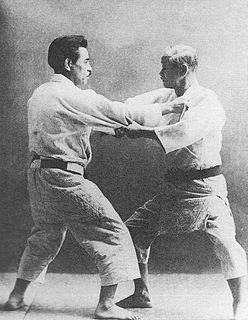
In grappling, side control is a dominant ground grappling position where the top combatant is lying perpendicularly over the face-up bottom combatant in such a way that the legs are free and he or she exerts no control over the combatant on the bottom. The top combatant is referred to as having side control, and is in a stable position, with the other combatant pinned beneath him or her. From there the top combatant can proceed with elbows, knees, various submissions, or transition into a mounted position. It is high priority for the bottom combatant to sweep the top combatant or otherwise escape the position, for instance by entangling the opponent's free legs and trying to obtain the half guard or guard.

In combat sports, the north–south position is a ground grappling position where one combatant is supine, with the other combatant invertedly lying prone on top, normally with his or her head over the bottom combatant's chest. The north–south position is a dominant position, where the top combatant can apply effective strikes such as knee strikes to the head, or easily transition into various grappling holds or more dominant positions. Transitioning into side control can be done by first switching into a particular hold known as ushiro-kesa-gatame (後袈裟固) or reverse scarf hold, where the chest points to the side, and the opponent's arm is controlled similarly to kesa-gatame. The north–south choke is employed exclusively from this position.
Katame no Kata is one of the two Randori-no-kata of Kodokan Judo. It is intended as an illustration of the various concepts of katame-waza that exist in judo, and is used both as a training method and as a demonstration of understanding.
Kōdōkan Goshin Jutsu or Kōdōkan goshinjutsu is the most recent Judo kata of Kodokan and was established in 1956. Compared to Kime no kata it is a more modern set of self-defence techniques. Instead of attacks with swords, the kata contains defences against attacks with stick and pistol.
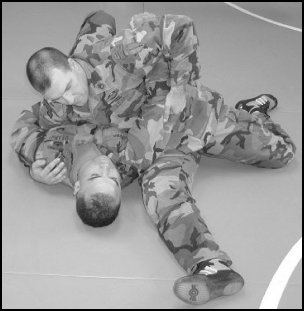
Kuzure-Kesa-Gatame (崩袈裟固) is one of the seven mat holds, Osaekomi-waza, of Kodokan Judo. In grappling terms, it is categorized as a side control hold.

Kata-Gatame (肩固) is one of the seven mat holds, Osaekomi-waza, of Kodokan Judo. It is also one of the 25 techniques of Danzan Ryu's constriction arts, Shimete, list. In grappling terms, it is categorized as a side control hold. Primarily used as a hold down in Judo, it is mostly used as a choke in Jiu-Jitsu and mixed martial arts. WWE wrestler Braun Strowman and former Impact Wrestling Superstar, Samuel Shaw use this move as their finishing maneuver.
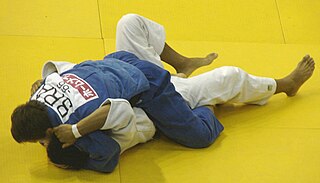
Tate-Shiho-Gatame (縦四方固) is one of the seven mat holds, Osaekomi-waza, of Kodokan Judo. In grappling terms, it is categorized as a mounted position.
Yoko-shiho-gatame (横四方固め) is one of the seven mat holds, Osaekomi-waza, of Kodokan Judo. In grappling terms, it is categorized as a side control hold.
Kuzure-Kami-Shiho-Gatame (崩上四方固) is one of the seven mat holds, Osaekomi-waza, of Kodokan Judo, a variation of Kami shiho gatame. In grappling terms, it is categorized as a north-south hold.
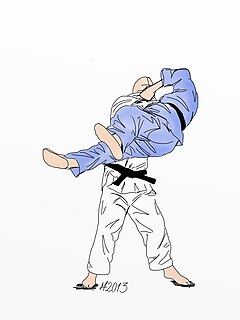
Ushiro Goshi (後腰), is one of the original 40 throws of Judo as developed by Jigoro Kano. It belongs to the fifth group, Gokyo, of the traditional throwing list, Gokyo-no-Nagewaza, of Kodokan Judo. It is also part of the current 67 Throws of Kodokan Judo.

Ude-Hishigi-Ude-Gatame (腕挫腕固) is one of the official 29 grappling techniques of Kodokan Judo. It is one of the nine joint techniques of the Kansetsu-waza list, one of the three grappling lists in Judo's
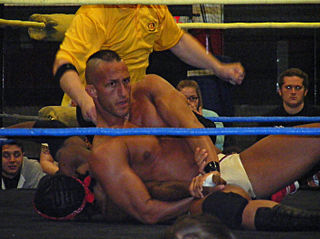
Ude-Hishigi-Waki-Gatame is an armlock and one of the official 29 grappling techniques of Kodokan Judo. It is one of the nine joint techniques of the Kansetsu-waza list, one of the three grappling lists in Judo's Katame-waza enumerating 29 grappling techniques. Falling directly to the mat while applying or attempting to apply the Waki gatame in competition is listed as an Hansoku-make by the International Judo Federation.
Ude-Hishigi-Sankaku-Gatame (腕挫三角固), also referred to as Ao muke gata ude hishigi (背中方腕挫) in the Canon Of Judo, is one of the official 29 grappling techniques of Kodokan Judo. It is one of the nine joint techniques of the Kansetsu-waza list, one of the three grappling lists in Judo's Katame-waza, enumerating 29 grappling techniques, and is also demonstrated by Kyuzo Mifune in the video The Essence of Judo.

Koshi Guruma (腰車), is one of the original 40 throws of Judo as developed by Jigoro Kano. It belongs to the second group,
Ushiro-Kesa-Gatame is one of the variations of Kesa-Gatame, a mat hold, listed in The Canon Of Judo.
Ura-Kesa-Gatame is one of the variations of Kuzure-Kesa-Gatame, a mat hold, listed in The Canon Of Judo.
